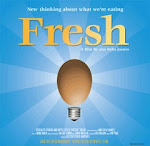
Here’s a Provencal-inspired update to the old somewhat fearful diet cabbage soup. This version is still full of high fiber, low-carb vegetables, and makes an excellent fat burner meal. But the undeniable best part is the splurge of Pistou, a traditional Provencal sauce very similar to an Italian pesto, but without the nuts to add unwanted calories. I don't dare call this soup a Soup au Pistou - no beans of any kind to challenge the diet discipline here! But this soup, even before the dollop of Pistou goes on, has real flavor merit: lots of baby bell peppers, fresh fennel and savory savoy, cooked in a light vegetable broth and flavored with fresh thyme and dried orange peel. Let the calories disappear with the sip of the spoon!
Diet Soup with Pistou
The Light Vegetable Stock
(make more or even double - this stock is wonderful for poaching fish, too!)
1 large shallot, or small onion, sliced
handful of celery leaves and stem parts
handful of parsley with stems
1 small carrot, rough diced
salt and pepper to taste
large pinch of tarragon
4 cups of water
1/4 cup white wine
Simmer all the vegetables in the water for 10 minutes, then add the wine and continue to simmer 5 to 8 minutes more.
Strain out the vegetables and set aside for the soup.
The Ingredients
Do get all the vegetables and spices ready before getting started with the soup!
1 onion, diced fine
2 garlic cloves, diced
1 small whole celery heart, chopped or 4 -5 stalks
1 small fennel bulb, diced
1 package mixed color mini bell peppers, sliced in 1/4 inch rounds
1/2 savoy cabbage, cut in 1/2 inch ribbons
2 roma tomatoes, peeled, seeded and chopped
1 to 2 tablespoons extra virgin olive oil (the less you use, the more you lose!)
few sprigs of fresh thyme
2 -3 peels of orange rind, with as little pith as possible
pinch of bouquet garni
salt and pepper to taste
4 cups of broth
1 cup of water
For the Pistou
recipe courtesy of Paul Wolfert, Food and Wine, Aug 2006
2-1/2 cups of rough torn fresh basil leaves
1 large tomato, seeded and grated
1 scant teaspoon sea salt or kosher salt
4 cloves of garlic, rough chopped
1/4 cup olive oil
1/4 cup grated cheese - Paula Wolfert suggests a Mimolette or aged Gouda.
(with deference to Paula's unerring great taste, I suggest a mix of aged Parma and gruyere as more accessible substitues)
The Preparation
Start the soup by heating the oil. Add in onions and garlic, celery and fennel and simmer, covered, 5 to 8 minutes minutes. Add in bell peppers and cabbage, and just when the cabbage begins to wilt, stir in the broth and water and all the seasonings.
Here's how fresh the veggies look after the initial simmer:

Bring to a boil and simmer, uncovered, 15 minutes. Add in the tomatoes and continue to cook another 10 minutes, or until vegetables are tender but not mushy. Cabbage should still be bright green, not brown!
While the soup is simmering, prepare the Pistou. You will need a mortar and pestle: the basil, garlic and salt, smashed against the sides of the mortar will truly be much silkier than the results from a food processor - and its really not much work. That said, start with the salt and garlic, and work with the pestle until you have a smooth paste. Add in basil, working by handfuls, and smash against the sides until well integrated into the paste. Add in the grated tomato and continue to work with the pestle. Gradually stir in the oil until well incorporated, and finally, fold in the grated cheese. Pistou can be made somewhat ahead and refrigerated until ready to serve.
To serve, ladle the soup generously into wide soup plates, and garnish with a good spoonful full of Pistou.

And if noone is dieting, don't hold the country fresh bread. There's bound to be extra pistou to for dipping.
And for those watching their curves, here's the nutritional breakdown, per serving with 1 tablespoon of Pistou. Enjoy!
Calories 267
Protein 7 grams
Fat 14 grams
Effective carbs 21 grams











